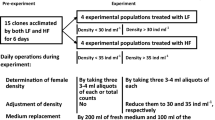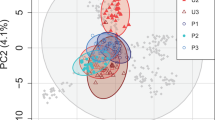Abstract
In an earlier study we found that the rotifer Brachionus plicatilis in Soda Lake, Nevada (USA) maintains extensive genetic variation for three isozymes. This variation was present both within and between different collections. No evidence was found that there was a seasonal succession of distinct electromorphs. In this paper we ask: is the genetic variation maintained by selective neutrality among electromorphs? Parthenogenetic females from ten clones representing seven different composite electromorphs were selected for life table analysis. Substantial main effects of genotype or interactions of genotype with experimental food quantities and temperatures, were found for the intrinsic rates of increase, net reproductive rates, and mean life spans of these clones. We conclude that these fitness differences permit us to reject the hypothesis that genetic variation is maintained because of selective neutrality among clones. Instead, it seems likely that directional selectional may be either too weak or of too brief a duration in Soda Lake for clonal exclusion to occur.
Similar content being viewed by others
References
Birch, L. C., 1948. The intrinsic rate of natural increase of an insect population. J. anim. Ecol. 17: 15–26.
Epp, R. W. & W. M. Lewis, Jr., 1979. Sexual dimorphism in Brachionus plicatilis (Rotifera): evolutionary and adaptive significance. Evolution 33: 919–928.
Fukusho, K. & M. Okauchi, 1984. Seasonal Isolation between two strains of rotifer Brachionus plicatilis in an eel-culture pond. Bulletin of the Japanese Society of Scientific Fisheries. 50: 909.
Hebert, P. D. N., 1983. Clonal diversity in cladoceran populations, In: C. E. King & P. S. Dawson (eds.), Population Biology: Retrospect and Prospect. Columbia University Press, N.Y.: 37–61.
Hebert, P. D. N. & T. J. Crease, 1980. Clonal coexistence in Daphnia pulex (Leydig): another plankton paradox. Science 207: 1363–1365.
Hebert, P. D. N. & R. D. Ward, 1976. Enzyme variability in natural populations of Daphnia magna. IV. Ecological differentiation and frequency changes of genotypes at Audley End. Heredity 36: 331–341.
Kazutaugu, H. & K. Takashi, 1972. Fundamental Studies on physiology of rotifer for its mass culture. II: Influence of water temperature on population growth of rotifer. Bull. Japanese Soc. of Scientific Fisheries 38: 1357–1363.
King, C. E., 1972. Adaption of rotifers to seasonal variation. Ecology 53: 408–418.
King, C. E., 1977. Genetics of reproduction, variation and adaptation in rotigers. Arch. Hydrobiol. Beih. Ergebn. Limnol. 8: 187–201.
King, C. E., 1980. The genetics of zooplankton populations. In: W. C. Kerfoot (dd.), Evolution and Ecology of Zooplankton Communities. University Press of New England, New Hampshire: 315–328.
King, C. E., 1982. The evolution of lifespan. In: H. Dingle & J. P. Hegman (eds.), Evolution and Genetics of Life Histories. Springer-Verlag, New York: 121–138.
King, C. E. & Y. Zhao, 1987. Coexistenceof rotifer (Brachionus plicatilis) clones in Soda Lake, Nevada. Hydrobiologia 147: 57–64.
Loaring, J. M. & P. D. N. Hebert, 1981. Ecological differences among clones of Daphnia pulex Leydig. Oecologia 51: 162–168.
Lynch, M., 1983. Ecological genetics of Daphnia pulex. Evolution 37: 358–374.
Lynch, M., 1984. The genetic structure of a cyclic parthenogen. Evolution 38: 186–203.
Snell, T. W. & C. E. King, 1977. Lifespan and fecundity pattern in rotifers: the cost of reproduction. Evolution 31: 882–890.
Snell, T. W. & C. A. Hawkinson, 1983. Behavioral reproductive isolation among populations of the rotifer Brachionus plicatilis. Evolution 37: 1294–1305.
Snell, T. W., C. J. Bieberich & R. Fuerst, 1983. The effects of green and blue-green algal diets on the reproductive rate of the rotifer Brachionus plicatilis. Aquaculture 31: 21–30.
Vrijenhoek, R. C., 1979. Factors affecting clonal diversity and coexistence. Am. Zool. 19: 787–797.
Weider, L. J., 1984. Spatial heterogeneity of Daphnia genotypes: vertical migration and habitat partitioning. Limnol. Oceanogr. 29: 225–235.
Weider, L. J. & P. D. N. Hebert, 1987. Ecological and physiological differentiation among low-arctic clones of Daphnia pulex. Ecology 68: 188–198.
Young, J. P. W., 1979. Enzyme polymorphism and cyclic parthenogenesis in Daphnia magna. I. Selection and clonal diversity. Genetics 92: 199–202.
Young, J. P. W., 1984. The population structure of cyclic parthenogens. In: G. S. Oxford & D. Rollinson (eds.), Systematics Association Spatial Volume No. 24, Protein Polymorphism: Adaptive and Taxonomic Significance. Academic Press, N.Y., 361–378.
Author information
Authors and Affiliations
Rights and permissions
About this article
Cite this article
Zhao, Y., King, C.E. Ecological genetics of the rotifer Brachionus plicatilis in Soda Lake, Nevada, USA. Hydrobiologia 185, 175–181 (1989). https://doi.org/10.1007/BF00036605
Received:
Revised:
Accepted:
Issue Date:
DOI: https://doi.org/10.1007/BF00036605




